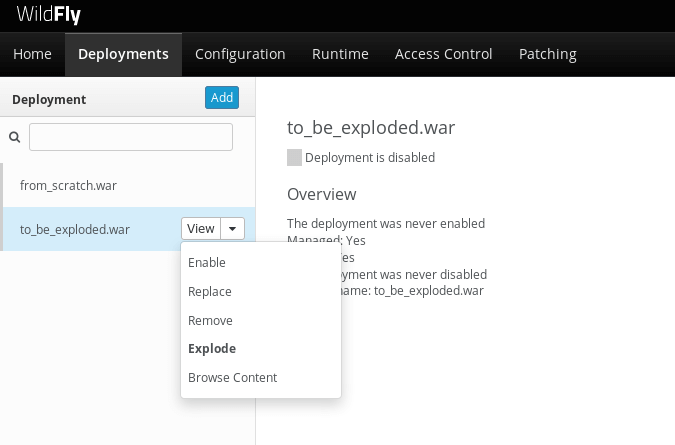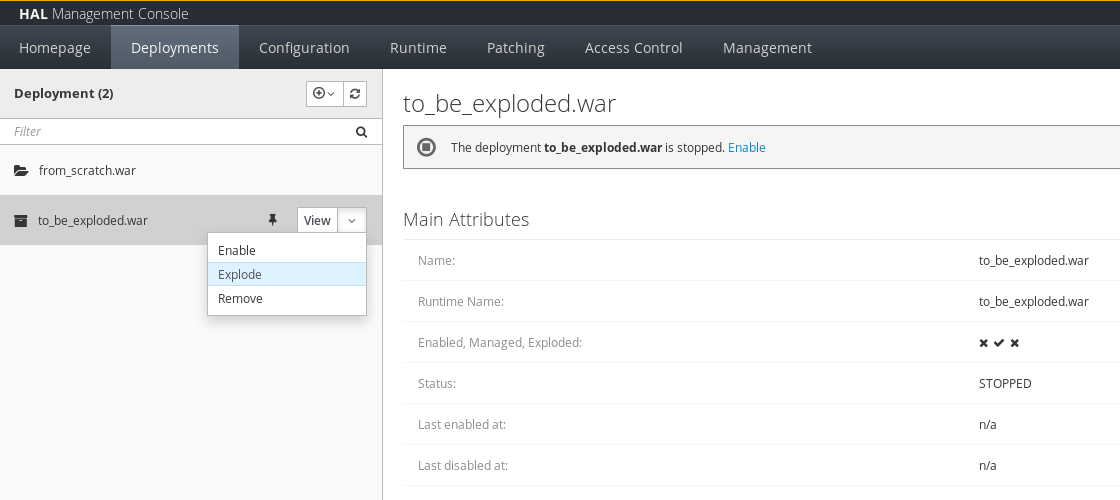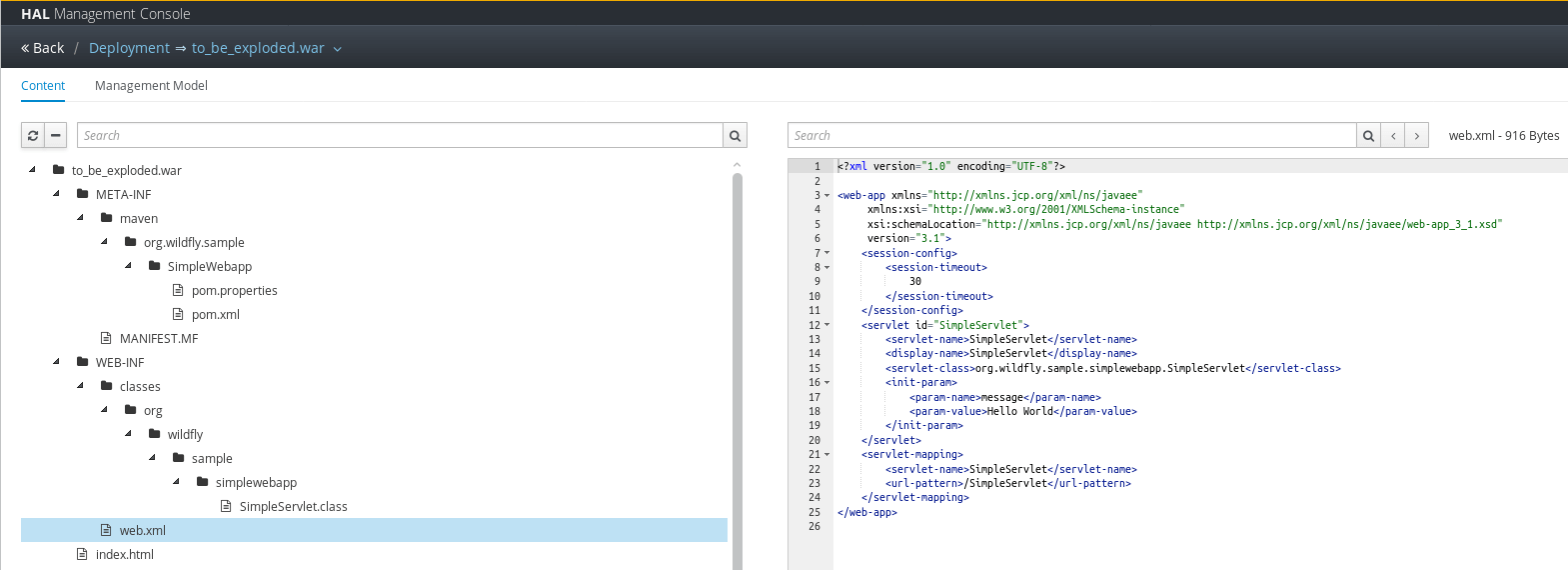How to Deploy War File in Wildfly 10
Now you can read content from a deployment, so you can directly see what's in your deployment. This operation can be use to browse the content of a deployment and read or download its files (even from inside an archive file).
Using the JBoss CLI
Using the browse-content operation you can have the list of files in the deployment :
[standalone@localhost:9990 /] /deployment=to_be_exploded.war:browse-content { "outcome" => "success", "result" => [ { "path" => "META-INF/", "directory" => true }, { "path" => "META-INF/MANIFEST.MF", "directory" => false, "file-size" => 134L }, { "path" => "WEB-INF/", "directory" => true }, { "path" => "WEB-INF/classes/", "directory" => true }, { "path" => "WEB-INF/classes/org/", "directory" => true }, { "path" => "WEB-INF/classes/org/wildfly/", "directory" => true }, { "path" => "WEB-INF/classes/org/wildfly/sample/", "directory" => true }, { "path" => "WEB-INF/classes/org/wildfly/sample/simplewebapp/", "directory" => true }, { "path" => "WEB-INF/web.xml", "directory" => false, "file-size" => 916L }, { "path" => "WEB-INF/classes/org/wildfly/sample/simplewebapp/SimpleServlet.class", "directory" => false, "file-size" => 2302L }, { "path" => "index.html", "directory" => false, "file-size" => 234L }, { "path" => "META-INF/maven/", "directory" => true }, { "path" => "META-INF/maven/org.wildfly.sample/", "directory" => true }, { "path" => "META-INF/maven/org.wildfly.sample/SimpleWebapp/", "directory" => true }, { "path" => "META-INF/maven/org.wildfly.sample/SimpleWebapp/pom.xml", "directory" => false, "file-size" => 2992L }, { "path" => "META-INF/maven/org.wildfly.sample/SimpleWebapp/pom.properties", "directory" => false, "file-size" => 125L } ] } You can reduce the output by filtering using the path, depth and archive parameters. For exemple
[standalone@localhost:9990 /] /deployment=to_be_exploded.war:browse-content(path=WEB-INF/, depth=1) { "outcome" => "success", "result" => [ { "path" => "web.xml", "directory" => false, "file-size" => 916L }, { "path" => "classes/", "directory" => true } ] } So now we can display the content of the web.xml. Using the read-content operation is not sufficient enough as it will return an attachment:
[standalone@localhost:9990 /] /deployment=to_be_exploded.war:read-content(path=WEB-INF/web.xml) { "outcome" => "success", "result" => {"uuid" => "c778c51e-a507-4a71-a21f-d6af8b230db4"}, "response-headers" => {"attached-streams" => [{ "uuid" => "c778c51e-a507-4a71-a21f-d6af8b230db4", "mime-type" => "application/xml" }]} } So we need to combine this operation with the attachment operation like this :
[standalone@localhost:9990 /] attachment display --operation=/deployment=to_be_exploded.war:read-content(path=WEB-INF/web.xml) ATTACHMENT 582a10e0-5159-4d2b-8d07-8d39af0df8c3: <?xml version="1.0" encoding="UTF-8"?> <web-app xmlns="http://xmlns.jcp.org/xml/ns/javaee" xmlns:xsi="http://www.w3.org/2001/XMLSchema-instance" xsi:schemaLocation="http://xmlns.jcp.org/xml/ns/javaee http://xmlns.jcp.org/xml/ns/javaee/web-app_3_1.xsd" version="3.1"> <session-config> <session-timeout> 30 </session-timeout> </session-config> <servlet id="SimpleServlet"> <servlet-name>SimpleServlet</servlet-name> <display-name>SimpleServlet</display-name> <servlet-class>org.wildfly.sample.simplewebapp.SimpleServlet</servlet-class> <init-param> <param-name>message</param-name> <param-value>Hello World</param-value> </init-param> </servlet> <servlet-mapping> <servlet-name>SimpleServlet</servlet-name> <url-pattern>/SimpleServlet</url-pattern> </servlet-mapping> </web-app> And to save this content locally we can use:
[standalone@localhost:9990 /] attachment save --operation=/deployment=to_be_exploded.war:read-content(path=WEB-INF/web.xml) --file=/home/ehsavoie/tmp/web.xml File saved to /home/ehsavoie/tmp/web.xml Using the web console
Navigate to 'Deployments' and select the deployment you want to browse. Then open the context menu and choose Browse Content:

This opens a new page with the contents of the deployment. For each file, there's a link with the full path and size of the file. Click on the link to download the file:

Using HAL.NEXT
The next major version of the web console (HAL.next) is currently under active development and is available as technical preview https://github.com/hal/hal.next. Follow the instruction in https://github.com/hal/hal.next#running to get started. Besides general improvements like better navigation and a revisited look and feel, HAL.next comes with many improvements for dealing with deployments:
-
Add Deployments using drag & drop.
-
New content browser using a tree view and an editor with syntax highlighting.
-
Download complete deployments or single files of a deployment.
Select deployments and just click on View to display its content:

This opens a new page which allows for a really nice way to browse and read content from a deployment:

How to Deploy War File in Wildfly 10
Source: https://www.wildfly.org/news/2017/09/08/Exploded-deployments/
0 Response to "How to Deploy War File in Wildfly 10"
Post a Comment